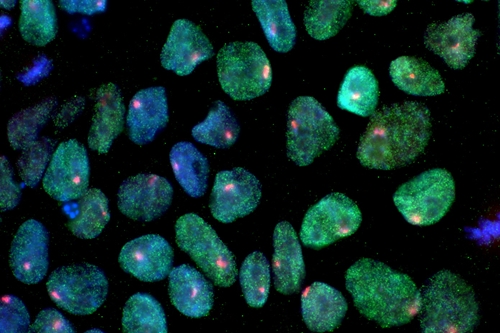
Induced pluripotent stem cells reprogrammed from human skin (California Institute for Regenerative Medicine)
24 March 2017. A new technology targets the expression of genes in stem cells to produce specific brain and muscle cells on demand and in a few days, a fraction of the time now required. A team from University of Cambridge and Wellcome Trust Sanger Institute, also in Cambridge, U.K. describes the technology the 23 March issue of the journal Stem Cell Reports.
Researchers led by Cambridge neuroscience professor Mark Kotter are seeking faster and more reliable methods for producing functioning human cells from stem cells for research and eventually treatments. Current methods for inducing human pluripotent stem cells — the type of stem cells that can transform into almost type of tissue — into brain and muscle cells take from 3 to 20 weeks, say the authors. And techniques for altering the genes in the stem cells use lentiviruses, benign viruses to deliver modified or healthy genes to the cells, which the authors say are imprecise, and can cause complications and require further purification steps.
Kotter and colleagues devised a different approach for producing functioning cells from stem cells, which they call OPTi-OX, short for OPTimised inducible OvereXpression. This technology induces the expression of proteins known as transcription factors that transcribe, or convert, genetic codes in DNA into instructions in RNA for cells to function. Their process adapts techniques from gene therapy that seek out genomic safe harbors for delivery of healthy genes, but in this case to induce the expression of genes to produce many copies of functioning cells.
OPTi-OX works by reprogramming human embryonic stem cells to produce uniform functioning cells in large quantities. The reprogramming process is critical, since OPTi-OX is designed as a platform technology, where the precise genetic engineering of the stem cells determines the transcription factors and nature of the functioning cells being produced. The researchers envision canned genetic programs called cassettes inserted into stem cell genomes to produce large numbers of human cells on demand.
In the paper, the Cambridge and Wellcome Trust Sanger team produced neurons or nerve cells found in the brain, as well as oligodendrocytes, or “white matter” cells that support brain functions. The researchers also produced skeletal muscle cells called myocytes. The OPTi-OX platform made it possible for researchers to adjust and refine the programming to produce these working human cells from stem cells in 5 to 10 days.
Production of oligodendrocytes by the team is considered particularly important because of the cells’ key roles in a number of neurological disorders, with promising therapeutic applications. But more immediate applications of OPTi-OX are high-throughput drug screens and toxicology testing performed as part of drug discovery.
“Neurons produced in this study are already being used to understand brain development and function,” says Kotter in a joint statement. “This method opens the doors to producing all sorts of hard-to-access cells and tissues so we can better our understanding of diseases and the response of these tissues to newly developed therapeutics.”
The institutions filed for patent protection on the OPTi-OX technology. In addition, Kotter and Cambridge entrepreneur Gordana Apic founded the company Elpis BioMed to commercialize the technology. The start-up enterprise, incorporated in November 2017, aims to become a supplier of functioning cells for academic research and drug discovery.
More from Science & Enterprise:
- Stem Cells Launched on Current SpaceX Flight
- Gene Expression Changes Found in Wound Healing Therapy
- Trial to Test Stem Cells for Treating Heart Failure
- Cell Biotech Gains Organoid Technology
- Start-Up Reprogramming Stem Cells to Treat Heart Failure
* * *

 RSS - Posts
RSS - Posts
You must be logged in to post a comment.